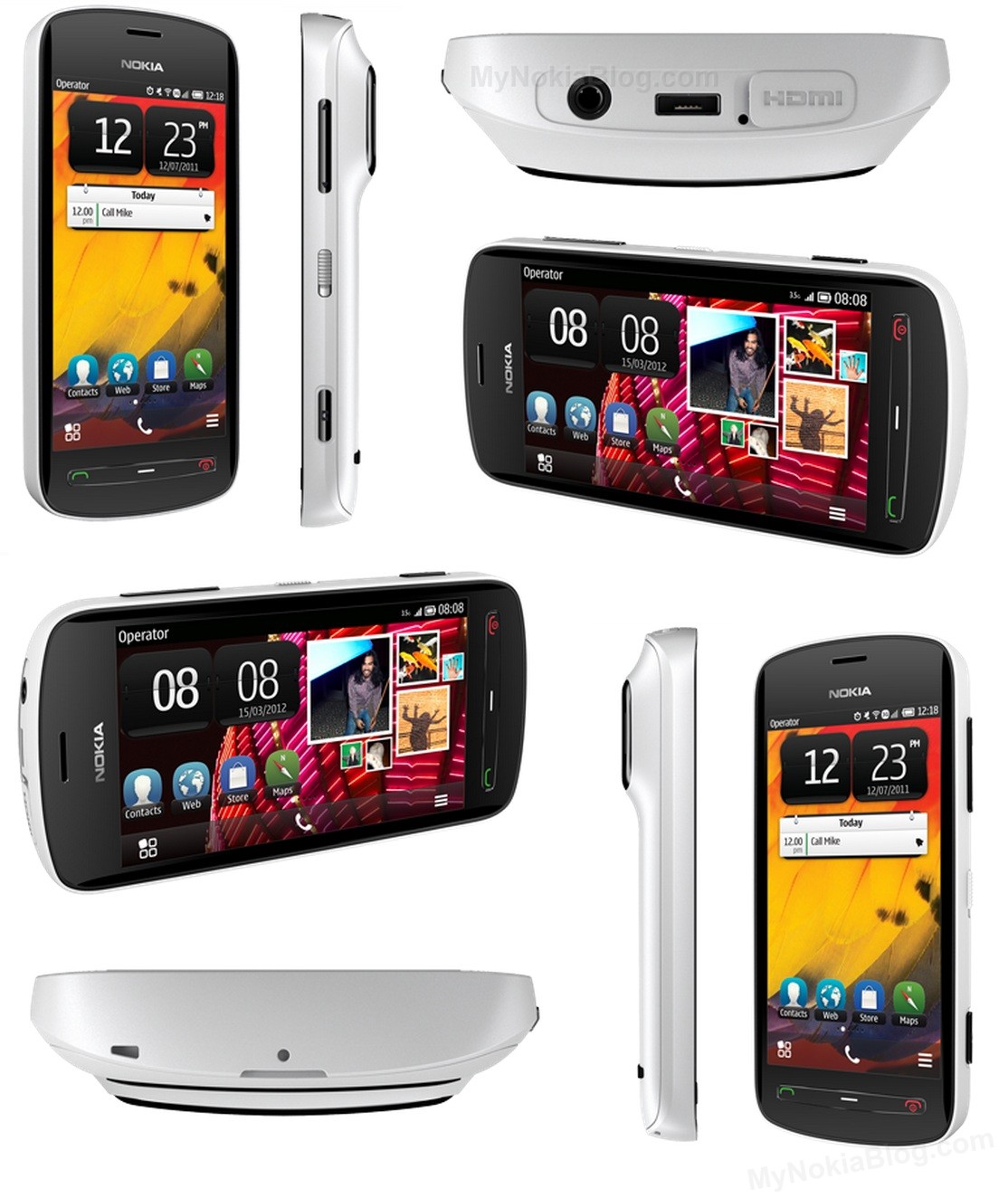
 | |
| Manufacturer | NOKIA |
|---|---|
| Predecessor | nokia n8 |
| Dimensions | 123.9 mm (4.88 in) H 60.2 mm (2.37 in) W 13.9 mm (0.55 in) D |
| Weight | 169 g (6.0 oz) |
| Operating system | nokia belle Feature Pack 1, upgradeable to nokia BelleFeature Pack 2 |
| CPU | 1.3 GHz ARM11 |
| Memory | 512 MB RAM |
| Storage | 16 GB on-board memory |
| Removable storage | microSD up to 64 GB supported w/ microSDXC support |
| Battery | Li-Ion; BV-4D 1400 mAh 3.8 V |
| Display | 4-inch AMOLED 2.5D curved nHD display Gorilla glass with easy-clean coating |
| Rear camera | 41 Mpx (1/1.2") sensor Carl Zeiss Optics F-number: f/2.4 ND filter Xenon Flash LED video light 1080p 30 fps video with Continuous AutoFocus |
| Front camera | 0.3 Mpx; 480p 30 fps |
| Connectivity | BLUE TOOTH 3.0 Wi-Fi 802.11 b/g/n DLNA Micro HDMI Micro USB USB On-The-Go Secure NFC 3.5 mm audio connector withTV-out FM TRANSMITTER GPS with a-gps |

Pureview Pro camera
PureView Pro is an imaging technology used in the Nokia 808 PureView device. It is the combination of a 1/1.2" large,[7] very high resolution 41Mpix image sensor with high performance Carl Zeiss optics. The large sensor enables pixel oversampling, which means the combination of many sensor pixels into one image pixel. PureView imaging technology delivers high image quality, lossless zoom, and improved low light performance (see below). It dispenses with the usual scaling/interpolation model of digital zoom used in virtually all smartphones, as well as optical zoom used in most digital cameras, where a series of lens elements moves back and forth to vary the magnification and field of view. In both video and stills, this technique provides greater zoom levels as the output picture size reduces, enabling 4x zoom in full HD 1080p video, 6x lossless zoom for 720p HD, and 12x zoom for nHD (640x360) video.

Image sensor
PureView Pro sensor has an active area of 7728 x 5368 pixels, totalling over 41 Mpix. Depending on the aspect ratio chosen by the user, it will use 7728 x 4354 pixels for 16:9 images/videos, or 7152 x 5368 pixels for 4:3 images/videos. What happens next depends on the settings and whether or not zoom is used. But to give an idea, the default still image setting is 5 Mpix at 16:9, and for video, 1080p at 30 FPS. Using these settings, the zoom is around 3x for stills and 4x for video. Conventional digital zoom tends to scale up images from a relatively low resolution, resulting in poor image quality.
The image sensor is capable not only of delivering parts of its pixels, but of down- or oversampling its resolution by having its own on-chip image processor, highly reducing external processing needs and data rates as well as image noise (see noise shaping) when lower resolutions (or HD video) are needed. Additionally this provides very high image resolution. Images up to 38 megapixels can be taken at full resolution at 4:3 aspect ratio and 34 megapixels at 16:9 ratio.

[edit]Lens
The optic is a 1-group lens, which is based on a shiftable fixed-focus lens: similar to the highly regarded prime lenses in most Zeiss Planar or Tessar optics, focus is achieved by varying the distance to the image sensor (unit focusing lens). This construction has the advantage that no movable focus group is needed. Considerable movable (focus-range) lens groups need a minimum of one additional adaptive lens element in both the moved group and the stationary group, increasing the number of elements by at least two. This increases unwanted reflections as well as overall tolerances and therefore decreases sharpness.
The lens consists of only 1 group with molded elements, which gives a highly stable, precise mechanical alignment. The lenses are partly made of plastic, which provides sufficient stability at this size and as a 1-group lens and has the significant advantage of making it possible to use extreme aspheric shaped lens elements.[8]
5 all-aspherical lens elements are used, making it possible to increase border-sharpness and lower distortion and astigmatism. The high refractive index, low-dispersion glass additionally helps reduce chromatic aberrations. A neutral density filter with approximatelyND8 (3 f-stops) is employed for shooting in high light levels where normally a smaller aperture would be set. Although the lens is named a Tessar, it has almost nothing in common with the 4 element in 3 group, non-aspherical original Tessar.
Due to the comparatively large image sensor format of 1/1.2" and the comparatively fast lens with f/2.4, the camera has a quite shallowdepth of field of equivalent to approximately f/7.8 at 26 mm[10] on 35 mm full-frame.
[edit]Zoom
Zoom is digital but retains a high resolution due to the 41Mp sensor. The limit of the zoom is reached when the selected output resolution becomes the same as the input resolution. That means once the area of the sensor reaches 3072 x 1728, the zoom limit is reached. So the zoom always provides the true image resolution the user wants. The level of pixel oversampling is highest when zoom is not used. It gradually decreases until the maximum zoom is hit, where there is no oversampling. At this stage, PureView Pro optics and pixels start behaving in a more conventional way. But because only the centre of the optics is used, the best optical performance is achieved – including low distortion, no vignetting and highest levels of resolved detail. This also means that at full digital zoom, the noise reduction achieved by oversampling (pixel binning) is lost as no oversampling happens at full zoom.
[edit]Autofocus
PureView Pro features continuous auto focus in all shooting modes, close-up (Macro) focus, Face detection, Touch focus with easy manually selected focus point and Hyperfocal distance focus for defined depth of field, for extreme focus speed or when no reliable focus is possible due to darkness.
[edit]Video
The on-chip oversampling image processor of PureView Pro enables oversampling of all 38Mega-pixels even at the high video data rates of 1080p with 30 fps. Full HD 1080p gives 4x zoom; 720p HD video, 6x lossless zoom; and for nHD (640x360) video, 12x zoom. In addition, encoding is up to 25Mbps in 1080p H.264/MPEG-4 HD video format. The PureView Pro sensor integrates a special video processor that handles pixel scaling before sending the required number to the main image processor.
[edit]Audio
The 808 PureView employs Dolby Headphone software to transform stereo content to surround via 3.5mm A/V jack. It also includes Dolby Digital Plus software to provide 5.1 surround sound via HDMI or DLNA. The dual software from Dolby are embedded into the Nokia Belle feature pack 1 OS.
The 808 PureView is the first device to include the Nokia Rich Recording technology and has a frequency range between 25 Hz to around 19 kHz. The 808 PureView can capture sounds at the loudness level of 145 decibels without distortion. The two microphones, located at the top and the bottom enable ambient stereo recording. The audio encoding is done in AAC high profile, 128 kbit/s, 48000 Hz
No comments:
Post a Comment